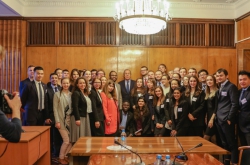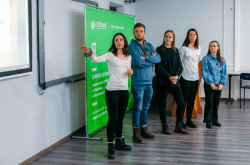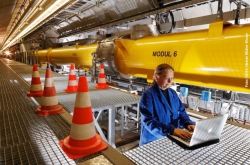The Erasmus+ program was launched in 2014 and is intended to continue until 2020. It focuses on introducing the European Union's strategy in the field of education: development of student mobility and cultural exchange, promotion of collaboration between universities and development of human and social capital in Europe and other countries in general.
Who can participate?
All EU countries, as well as Iceland, Liechtenstein, Norway, the Republic of Macedonia and Turkey can participate in the program. These participant-countries can instigate their own projects; yet, there are also partner-countries that can participate in their projects; among those are Russia, countries of the Western Balkans, Eastern Partnership, Southern Mediterranean, Central Asia, Latin America, Africa, and the Caribbean (all in all, 13 regions).
Erasmus+: programs
Numerous programs in different fields are part of Erasmus+. Yet, there are two main modules that have to do with higher education that Maria Sigutina, ITMO's representative in Brussels, advises to pay attention to. The first has to do with supporting short-term academic mobility programs for students, staff and professors (International Credit Mobility). The second is dedicated to collaboration for stimulating innovations and experience exchange; it includes a program for supporting innovations in the field of higher education (Strategic Partnership), and a program for supporting the development of entrepreneurial skills and ties with industry and business (Knowledge Alliance).
 Maria Sigutina
Maria Sigutina
Short-term academic mobility between EU and Russia
This is a simple and popular project for collaboration with European universities that is aimed at both students and academic staff. One should bear in mind that a Russian university can only be a partner in such a collaboration, but not the project's instigator - so, to become part of the program, it needs to have a partner university from a participant-country of Erasmus+ program. In other words, it needs to have a European university that can freely instigate a project or a program.
Such projects last from 16 to 26 months; the financing is decided on a competitive basis. Each individual participant of the program (i.e. student or member of academic staff) gets a scholarship that covers his insurance, as well as transport and living expenses.
What do students get?
For students, the scholarship can be from 650 to 900 Euros per month depending on the country, plus transport expenses. Such programs last for from 3 to 12 months. Upon completion of the program, the students get ECTS points. It is compulsory that a Russian university that is part of the collaboration accepts them.
 Credit: ec.europa.eu
Credit: ec.europa.eu
What do academic staff members get?
Academic staff members can go to partner universities to upgrade their skills; such trips can last from 5 days to 2 months. They get a scholarship (from 100 to 140 Euros a day depending on the country), and their travel expenses are covered.
There also are similar programs for professors and lecturers; those get scholarships of about 2000 Euros a month, and can also combine teaching with career enhancement. Yet, one has to note that a professor going on such a program has to spend no less than 8 hours a week on teaching.
The application
The mobility programs can be unequal - for instance, if two research students come to a Russian university, this doesn't mean that the university can only send two people abroad. The main condition is that the program's length and participants must be justified and substantiated in detail in the application.
There are four compulsory paragraphs in every application. For instance, a Russian participant and his European partner have to specify their universities' internationalization strategy and what role will their collaboration project play in it.
 Participants of the seminar on Erasmus+
Participants of the seminar on Erasmus+
"Everything prior to your collaboration project shall look like some ideal love story. You have to write everything about the visits between you and your partner, your agreement and also describe what results will your projects bring to each of the participants," explains Maria Sigutina.
What is more, you also have to add a guided plan for the academic mobility program, as well as state the opportunities of information provision and such.
ITMO University already has such programs with universities of Germany, France, Ireland, Belgium, Portugal, Greece, Estonia and Cyprus, and this list is constantly growing.
"Recently, head of ITMO's SCAMT International Laboratory Vladimir Vinogradov and head of the university’s Biological Cluster Alexander Vinogradov initiated an application for an Erasmus+ International Credit Mobility program in collaboration with the University of Aveiro (Portugal). It has already been approved by Erasmus+ National Agency in Portugal, so the students from the two universities will start their exchange programs as soon as this September. What is more, ITMO's students from the School of Computer Technologies and Controls have already participated in a similar mobility program in collaboration with the University of Liège. Finally, in 2016 our collaboration application with Trinity College (Dublin) was accepted. This project will start in September, as well," notes Maria Sigutina.
When starting a collaboration with a new partner, one better start doing everything beforehand - half a year in advance, minimum. In this period of time, one has to come in agreement with representatives of the partner university, draft the application, send it to the partner university which, in its stead, will send it to Erasmus+ National Agency, and wait for their decision. The deadline for sending in applications on short-term mobility programs is February 1st.
 Alexandr Vinogradov
Alexandr Vinogradov
Strategic Partnership
This program focuses on supporting innovations and information exchange in the field of higher education. It implies creating collaborative courses on innovations (MOOCs and other online courses), modules and educational programs. Its main goal is exchange of experience between universities and enterprises. This module can also include organizing short-term mobility programs for lecturers to upgrade their skills.
The important difference from academic mobility programs here is that the amount of participants in this case is three representatives from three different countries minimum. Those can be universities, research institutes or enterprises, as well as local governmental bodies or non-profit organizations. The only establishment that can coordinate such a consortium is a European university; it will be the one to send its application to Erasmus+ National Agency of the corresponding country.
The National Agency distributes the funding between the projects on a competitive basis; the amount of funding for a single three-year project for the whole consortium cannot exceed 450 thousand Euros (in case of a short-term project, that would be 150 thousand a year). In case the application is approved, a participant from Russia can receive a grant of 50 to 70 thousand Euros for the whole project (or about 25 thousand a year).
ITMO's experience: Creation of the International Virtual Laboratory and the innovative educational module on the Internet of Things - IOT-OPEN.EU
This unique international project has been around since December 2016 as part of a Strategic Partnership project in consortium with a Polish coordinator - the University of Silesia, as well as Riga Technical University, Tallinn University of Technology, University of Messina and the Estonian IT company ITT Group.
 Credit: ec.europa.eu
Credit: ec.europa.eu
Its goal is to provide for a high level of training and educational materials for those who are only starting to expand their knowledge in the Internet of Things field, as well as provide relevant information for professionals. The platform includes classical educational courses, a MOOC module for those who prefer distant education, as well as access to Internet laboratories. In the latter case, the users will be able to work with real IoT devices and systems distantly. Also, the consortium aims to launch a network of laboratories for working with different platforms, including Arduino, Intel, Raspberry and others. The project is intended for 3 years.
Knowledge Alliance
The projects from this module are aimed at stimulating innovations, supporting entrepreneurs, promoting research, providing more opportunities for employment, knowledge exchange and interdisciplinary training. The main condition for participating in such programs is being part of a major consortium of European companies. In general, successful projects are carried out by a consortium of 9-10 participants, notes Maria Sigutina. They can be comprised of universities, research institutions, non-governmental organizations, local governmental bodies and enterprises - minimum three companies from three different EU countries. The consortium can only be coordinated by a European university. The competition here is really high, as each consortium will have to compete with dozens of similar groups from Europe's 27 countries.
The European Commission also gives funding to projects on a competitive basis. In this case, grants for the whole project exceed the sums given as part of a Strategic Partnership project by two times - for one project, a consortium can get no more than 1 million Euros. Such projects are intended for two to three years.
The application's author also has to substantiate that the current market is indeed in need of the collaboration project it proposes. The source of evidence for that can be both existing research and surveys as well as a university's independent research.
 Credit: ec.europa.eu
Credit: ec.europa.eu
How to start working with Erasmus+: six crucial points
As Maria Sigutina underlines, these three programs are most interesting in the context of building long-term cooperation with European universities. Not only does such partnership increase a university's internationalization level and its educational programs' quality, it also helps to considerably reimburse for the expenses on conducting its projects. What is more, if the university already has a good relationship with the academic community, instigating individual projects becomes much easier. Those who plan on starting a collaboration would find the following advice useful:
1. Define, how exactly can you realize your necessities with the help of academic mobility programs; as for Strategic Partnership and Knowledge Alliance programs, think about which projects you can conduct in collaboration with a European university (remember: you will have to substantiate the project's relevancy in detail right from the very start);
2. Based on this information, define the universities you and your partners already have contacts with (that better be a particular person you know well), and decide, which of them you would like to instigate a project with.
3. Contact your colleague in the other university in person and propose sending an application for an Erasmus+ program. Do not forget that after receiving an approval, your colleague from a European university will have to ascertain that their university agrees to include yours in their application at the university's Erasmus+ Office.
4. Contact the ITMO Representative Office in Brussels and get detailed information on how to compile your application. The Office's staff will help you draft your application based on the information you'll provide them with.
5. Send the text of your application to your partner university's Internationalization Office. If they approve your application, you colleague will send it to the Erasmus+ National Agency. Remember to keep yourself informed of your application's progress from here on.
6. You better start working on all of this in advance - a half a year beforehand minimum. For instance, if you're planning on applying for an academic mobility program, you better write to your European colleague this summer. In Europe, they don't like to do everything in the last moment. What is more, some additional time will let you correct your application if necessary, and monitor the work of all who will take part in the process.





